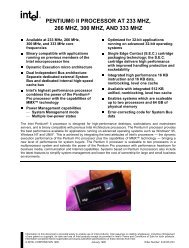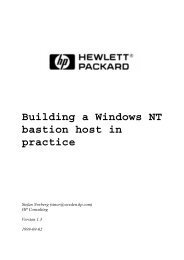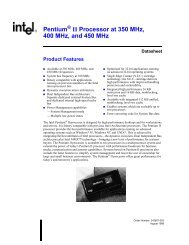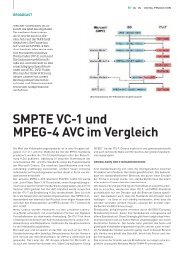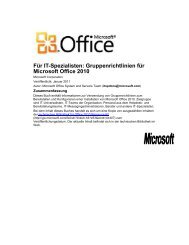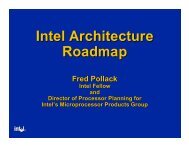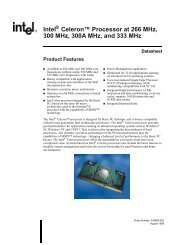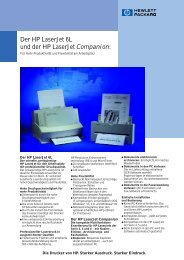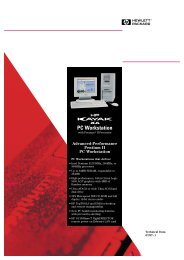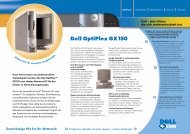Overview of Windows XP Service Pack 3.pdf - Download Center ...
Overview of Windows XP Service Pack 3.pdf - Download Center ...
Overview of Windows XP Service Pack 3.pdf - Download Center ...
Create successful ePaper yourself
Turn your PDF publications into a flip-book with our unique Google optimized e-Paper software.
<strong>Overview</strong> <strong>of</strong> <strong>Windows</strong> <strong>XP</strong> <strong>Service</strong> <strong>Pack</strong> 3<br />
Abstract<br />
<strong>Windows</strong>® <strong>XP</strong> <strong>Service</strong> <strong>Pack</strong> 3 (SP3) includes all previously released updates for the operating system,<br />
and a small number <strong>of</strong> new updates to ensure that <strong>Windows</strong> <strong>XP</strong> customers have the latest updates for<br />
their system. <strong>Windows</strong> <strong>XP</strong> SP3 will not significantly change the <strong>Windows</strong> <strong>XP</strong> experience. This white<br />
paper summarizes what is new in <strong>Windows</strong> <strong>XP</strong> SP3, and how to deploy the service pack.
This white paper is for informational purposes only. MICROSOFT MAKES NO<br />
WARRANTIES, E<strong>XP</strong>RESS OR IMPLIED, IN THIS DOCUMENT.<br />
Complying with all applicable copyright laws is the responsibility <strong>of</strong> the user. Without<br />
limiting the rights under copyright, no part <strong>of</strong> this document may be reproduced,<br />
stored in or introduced into a retrieval system, or transmitted in any form or by any<br />
means (electronic, mechanical, photocopying, recording, or otherwise), or for any<br />
purpose, without the express written permission <strong>of</strong> Micros<strong>of</strong>t Corporation.<br />
Micros<strong>of</strong>t may have patents, patent applications, trademarks, copyrights, or other<br />
intellectual property rights covering subject matter in this document. Except as<br />
expressly provided in any written license agreement from Micros<strong>of</strong>t, the furnishing<br />
<strong>of</strong> this document does not give you any license to these patents, trademarks,<br />
copyrights, or other intellectual property.<br />
© 2008 Micros<strong>of</strong>t Corporation. All rights reserved. Micros<strong>of</strong>t, <strong>Windows</strong>, <strong>Windows</strong><br />
Server, <strong>Windows</strong> Vista, <strong>Windows</strong> Live, OneCare, MSDN, and the <strong>Windows</strong> logo<br />
and are either registered trademarks or trademarks <strong>of</strong> Micros<strong>of</strong>t Corporation in the<br />
United States and/or other countries.<br />
The names <strong>of</strong> actual companies and products mentioned herein may be the<br />
trademarks <strong>of</strong> their respective owners. Micros<strong>of</strong>t Corporation • One Micros<strong>of</strong>t Way •<br />
Redmond, WA 98052-6399 • USA
Contents<br />
Introduction ......................................................................................... 3<br />
What Is In <strong>Service</strong> <strong>Pack</strong> 3 .................................................................... 4<br />
Previously Released Functionality 5<br />
New and Enhanced Functionality 6<br />
Deploying <strong>Windows</strong> <strong>XP</strong> SP3 ............................................................. 10<br />
Summary ............................................................................................ 11
Introduction<br />
Micros<strong>of</strong>t works to continually improve the performance, security, and stability <strong>of</strong> the <strong>Windows</strong> operating<br />
system. As part <strong>of</strong> this effort, Micros<strong>of</strong>t develops updates, fixes, and other improvements that address issues<br />
reported by the company’s<br />
customers and partners. To make<br />
it easier for customers to get<br />
these updates and<br />
enhancements, Micros<strong>of</strong>t<br />
periodically combines them into a<br />
single package, and makes that<br />
package available for all <strong>Windows</strong><br />
customers. These packages are<br />
called service packs.<br />
Performance<br />
Updates<br />
Stability<br />
Updates<br />
Security<br />
Updates<br />
<strong>Windows</strong> <strong>XP</strong> <strong>Service</strong> <strong>Pack</strong> 3<br />
(SP3) includes all previously<br />
released <strong>Windows</strong> <strong>XP</strong> updates,<br />
including security updates and<br />
hotfixes. It also includes select<br />
out-<strong>of</strong>-band releases, and a small<br />
number <strong>of</strong> new enhancements,<br />
which do not significantly change<br />
customers’ experience with the<br />
operating system.<br />
<strong>Service</strong> <strong>Pack</strong><br />
<strong>Windows</strong> <strong>XP</strong> SP3 provides a new baseline for customers still deploying <strong>Windows</strong> <strong>XP</strong>. For customers with<br />
existing <strong>Windows</strong> <strong>XP</strong> installations, <strong>Windows</strong> <strong>XP</strong> SP3 fills gaps in the updates they might have missed—for<br />
example, by declining individual updates when using <strong>Windows</strong> Update.<br />
<strong>Windows</strong> Vista provides the most advanced security and management capability, but for PCs that cannot be<br />
upgraded to <strong>Windows</strong> Vista right now, <strong>Windows</strong> <strong>XP</strong> SP3 ensures these PCs have all available updates and<br />
allows these PCs to leverage some new <strong>Windows</strong> Server 2008 capabilities, such as Network Access<br />
Protection (NAP).<br />
This white paper describes what is new in <strong>Windows</strong> <strong>XP</strong> SP3 and provides an overview <strong>of</strong> how customers can<br />
deploy the service pack.
What Is In <strong>Service</strong> <strong>Pack</strong> 3<br />
<strong>Windows</strong> <strong>XP</strong> SP3 includes all previously released <strong>Windows</strong> <strong>XP</strong> updates, including security updates and<br />
hotfixes, and select out-<strong>of</strong>-band releases. For example, the service pack includes functionality previously<br />
released as updates, such as the Micros<strong>of</strong>t® Management Console (MMC) 3.0 and the Micros<strong>of</strong>t Core XML<br />
<strong>Service</strong>s 6.0 (MSXML6).<br />
Micros<strong>of</strong>t is not adding significant functionality from newer versions <strong>of</strong> <strong>Windows</strong>, such as <strong>Windows</strong> Vista, to<br />
<strong>Windows</strong> <strong>XP</strong> through <strong>XP</strong> SP3. For instance, <strong>Windows</strong> <strong>XP</strong> SP3 does not include <strong>Windows</strong> Internet Explorer 7,<br />
although <strong>Windows</strong> <strong>XP</strong> SP3 does include updates to both Internet Explorer 6 and Internet Explorer 7, and it<br />
will update whichever version is installed on the computer. For more information about Internet Explorer 7,<br />
visit http://www.micros<strong>of</strong>t.com/windows/products/winfamily/ie/default.mspx.<br />
One notable exception is that, SP3 does include Network Access Protection (NAP) to help organizations that<br />
use <strong>Windows</strong> <strong>XP</strong> to take advantage <strong>of</strong> new features in the <strong>Windows</strong> Server® 2008 operating system.<br />
Knowledge Base article 936929 lists all other all Knowledge Base articles associated with updates that are<br />
included in <strong>Windows</strong> <strong>XP</strong> SP3. The following sections also provide a high-level description <strong>of</strong> the functionality<br />
included in <strong>Windows</strong> <strong>XP</strong> SP3.
Networking<br />
MSI<br />
MDAC<br />
Management<br />
Previously Released Functionality<br />
The functionality that Table describes is already available for <strong>Windows</strong> <strong>XP</strong> in stand-alone updates. System<br />
administrators must choose to install each <strong>of</strong> these updates, however. <strong>Windows</strong> <strong>XP</strong> SP3 includes them by<br />
default.<br />
Table . Previously Released Functionality<br />
Functionality<br />
MMC 3.0<br />
Description<br />
MMC 3.0 is a framework that unifies and simplifies day-to-day system<br />
management tasks in <strong>Windows</strong> by providing common navigation, menus,<br />
toolbars, and workflow across diverse tools. Micros<strong>of</strong>t Knowledge Base<br />
article 907265 describes this functionality in detail.<br />
MSXML6<br />
MSXML6 provides better reliability, security, and conformance with the<br />
XML 1.0 and XML Schema 1.0 W3C Recommendations. It also provides<br />
compatibility with System.XML 2.0.<br />
Micros<strong>of</strong>t <strong>Windows</strong><br />
Installer 3.1 v2<br />
(3.1.4000.2435)<br />
Background Intelligent<br />
Transfer <strong>Service</strong> (BITS)<br />
2.5<br />
IPSec Simple Policy<br />
Update for <strong>Windows</strong><br />
Server 2003 and<br />
<strong>Windows</strong> <strong>XP</strong><br />
<strong>Windows</strong> Installer 3.1 is a minor update to <strong>Windows</strong> Installer 3.0, which<br />
Micros<strong>of</strong>t released in September 2004. <strong>Windows</strong> Installer 3.1 contains new<br />
and enhanced functionality. Additionally, <strong>Windows</strong> Installer 3.1 addresses<br />
some issues that Micros<strong>of</strong>t found in <strong>Windows</strong> Installer 3.0. Micros<strong>of</strong>t<br />
Knowledge Base article 893803 describes this functionality.<br />
BITS 2.5 is required by Micros<strong>of</strong>t System <strong>Center</strong> Configuration Manager<br />
2007 and <strong>Windows</strong> Live OneCare. BITS 2.5 helps improve security. If<br />
you use BITS to transfer data, the new features also improve flexibility.<br />
Micros<strong>of</strong>t Knowledge Base article 923845 describes BITS 2.5.<br />
This update helps simplify the creation and maintenance <strong>of</strong> IPSec filters,<br />
reducing the number <strong>of</strong> filters that are required for a server and domain<br />
isolation deployment. The Simple Policy Update removes the requirement<br />
for explicit network infrastructure permit filters and introduces enhanced<br />
fallback to clear behavior. Micros<strong>of</strong>t Knowledge Base article 914841<br />
describes this previously released update in more detail.<br />
Digital Identity<br />
Management <strong>Service</strong><br />
(DIMS)<br />
Peer Name Resolution<br />
Protocol (PNRP) 2.1<br />
Remote Desktop<br />
Protocol 6.1<br />
DIMS make it possible for users who log on to any domain-joined computer<br />
to silently access all <strong>of</strong> their certificates and private keys for applications<br />
and services.<br />
This update enables <strong>Windows</strong> <strong>XP</strong> SP3–based programs that use PNRP to<br />
communicate with <strong>Windows</strong> Vista programs that use PNRP. Micros<strong>of</strong>t<br />
Knowledge Base article 920342 describes this previously released update.<br />
Remote Desktop Protocol (RDP) used for communication between the<br />
Terminal Server and the Terminal Server Client. RDP is encapsulated and<br />
encrypted within TCP. This update better facilitates communication
Networking<br />
Functionality<br />
Description<br />
between machines running <strong>Windows</strong> <strong>XP</strong> and <strong>Windows</strong> Vista. Knowledge<br />
Base article 186607 describes RDP. Knowledge base article 951616<br />
describes RDP 6.1.<br />
Wi-Fi Protected Access<br />
2 (WPA2)<br />
This update to <strong>Windows</strong> <strong>XP</strong> provides support for WPA2, the latest<br />
standards-based wireless security solution derived from the IEEE 802.11i<br />
standard. Micros<strong>of</strong>t Knowledge Base article 893357 describes this update.<br />
New and Enhanced Functionality<br />
Table describes some <strong>of</strong> the more significant changes in <strong>Windows</strong> <strong>XP</strong> SP3. With few exceptions, Micros<strong>of</strong>t is<br />
not adding new features or functionality from newer versions <strong>of</strong> <strong>Windows</strong> to <strong>Windows</strong> <strong>XP</strong> through SP3. As<br />
noted earlier, one exception is the addition <strong>of</strong> NAP to <strong>Windows</strong> <strong>XP</strong> to help organizations running <strong>Windows</strong> <strong>XP</strong><br />
to take advantage <strong>of</strong> new features in <strong>Windows</strong> Server 2008.<br />
For a list <strong>of</strong> Knowledge Base articles that <strong>Windows</strong> <strong>XP</strong> SP3 addresses, see Knowledge Base article 936929.<br />
Table . New and Enhanced Functionality<br />
Functionality<br />
"Black Hole" Router<br />
Detection<br />
Network Access<br />
Protection (NAP)<br />
CredSSP Security<br />
<strong>Service</strong> Provider<br />
Description<br />
<strong>Windows</strong> <strong>XP</strong> SP3 includes improvements to black hole router detection<br />
(detecting routers that are silently discarding packets), turning it on by<br />
default.<br />
NAP is a policy enforcement platform built into <strong>Windows</strong> Vista, <strong>Windows</strong><br />
Server 2008, and <strong>Windows</strong> <strong>XP</strong> SP3 with which you can better protect<br />
network assets by enforcing compliance with system health requirements.<br />
Using NAP, you can create customized health policies to validate<br />
computer health before allowing access or communication; automatically<br />
update compliant computers to ensure ongoing compliance; and optionally<br />
confine noncompliant computers to a restricted network until they become<br />
compliant. For more information about NAP, see Network Access<br />
Protection: Frequently Asked Questions.<br />
CredSSP is a new Security <strong>Service</strong> Provider (SSP) that is available in<br />
<strong>Windows</strong> <strong>XP</strong> SP3 via Security <strong>Service</strong> Provider Interface (SSPI). CredSSP<br />
enables an application to delegate the user’s credentials from the Client<br />
(via Client side SSP) to the target Server (via Server side SSP). <strong>Windows</strong><br />
<strong>XP</strong> SP3 involves only the Client side SSP implementation and is currently<br />
being used by RDP 6.1 (TS), though it can be used by any third party<br />
application willing to use the Client side SSP to interact with applications<br />
running Server side implementations <strong>of</strong> the same on Vista / LH Server.<br />
There is a technical specification <strong>of</strong> this SSP available at the Micros<strong>of</strong>t<br />
<strong>Download</strong> <strong>Center</strong>.<br />
Note that CredSSP is turned OFF by default in <strong>Windows</strong> <strong>XP</strong> SP3. To
Functionality<br />
Description<br />
enable CredSSP, administrators can modify the following registry keys:<br />
[HKEY_LOCAL_MACHINE\SYSTEM\CurrentControlSet\Control\Lsa]<br />
In the value ―Security <strong>Pack</strong>ages‖ <strong>of</strong> type REG_MULTI_SZ, add ―tspkg‖ in<br />
addition to SSP-specific data already present.<br />
[HKEY_LOCAL_MACHINE\SYSTEM\CurrentControlSet\Control\Securi<br />
tyProviders]<br />
In the value ―SecurityProviders‖ <strong>of</strong> type REG_SZ, add ―credssp.dll‖ in<br />
addition to SSP-specific data already present.
Security<br />
Functionality<br />
Descriptive Security<br />
Options User Interface<br />
Description<br />
The Security Options control panel in <strong>Windows</strong> <strong>XP</strong> SP3 now has more<br />
descriptive text to explain settings and prevent incorrect settings<br />
configuration. Figure shows an example <strong>of</strong> this new functionality.<br />
Figure . Security options explanatory text<br />
Enhanced security for<br />
Administrator and<br />
<strong>Service</strong> policy entries<br />
Micros<strong>of</strong>t Cryptographic<br />
Module<br />
In System <strong>Center</strong> Essentials for <strong>Windows</strong> <strong>XP</strong> SP3, Administrator and<br />
<strong>Service</strong> entries will be present by default on any new instance <strong>of</strong> policy.<br />
Additionally, the user interface for the Impersonate Client After<br />
Authentication user right will not be able to remove these settings.<br />
Implements and supports the SHA2 hashing algorithms (SHA256,<br />
SHA384, and SHA512) in X.509 certificate validation. This has been added<br />
to the crypto module rsaenh.dll.<br />
<strong>XP</strong> SP2 crypto modules Rsaenh.dll/Dssenh.dll/Fips.sys had been certified<br />
according to FIPS 140-1 specifications. The Federal Information<br />
Processing Standard (FIPS) 140-1 standard has been replaced by<br />
FIPS 140-2, and these modules have been validated and certified<br />
according to this standard. For more information, see the Micros<strong>of</strong>t Kernel<br />
Mode Cryptographic Module.
Setup<br />
Functionality<br />
<strong>Windows</strong> Product<br />
Activation<br />
Description<br />
As in <strong>Windows</strong> Server 2003 SP2 and <strong>Windows</strong> Vista, users can now<br />
complete operating system installation without providing a product key<br />
during a full, integrated installation <strong>of</strong> <strong>Windows</strong> <strong>XP</strong> SP3. The operating<br />
system will prompt the user for a product key later as part <strong>of</strong> Genuine<br />
Advantage.<br />
As with previous service packs, no product key is requested or required<br />
when installing <strong>Windows</strong> <strong>XP</strong> SP3 using the update package available<br />
through Micros<strong>of</strong>t Update.<br />
Note The <strong>Windows</strong> Product Activation changes in <strong>Windows</strong> <strong>XP</strong> SP3 are<br />
not related to the <strong>Windows</strong> Vista Key Management <strong>Service</strong> (KMS). This<br />
update affects only new operating system installations from integrated<br />
source media. This update affects the installation media only and is not a<br />
change to how activation works in <strong>Windows</strong> <strong>XP</strong>.
Deploying <strong>Windows</strong> <strong>XP</strong> SP3<br />
<strong>Windows</strong> <strong>XP</strong> SP3 will be available through <strong>Windows</strong> Update and the Micros<strong>of</strong>t <strong>Download</strong> <strong>Center</strong>. The service<br />
pack will also be available to Volume License customers, TechNet subscribers, and MSDN® subscribers.<br />
Through <strong>Windows</strong> Update, the download size varies, but it is typically 70 megabytes (MB), depending on the<br />
computer’s configuration. Through the <strong>Download</strong> <strong>Center</strong>, the download size is approximately 580 MB.<br />
Fundamentally, deploying <strong>Windows</strong> <strong>XP</strong> SP3 works the same as deploying SP1 and SP2 for <strong>Windows</strong> <strong>XP</strong>:<br />
<br />
<br />
<br />
<br />
<br />
SP3 is cumulative, so users can install SP3 on top <strong>of</strong> <strong>Windows</strong> <strong>XP</strong> SP1 or SP2.<br />
<strong>Windows</strong> <strong>XP</strong> SP3 supports the same languages as <strong>Windows</strong> <strong>XP</strong> did in its initial release.<br />
You can run the SP3 update package on any edition <strong>of</strong> <strong>Windows</strong> <strong>XP</strong> SP1 or SP2. For example, you can<br />
run the SP3 update package on a computer running the <strong>Windows</strong> <strong>XP</strong> Media <strong>Center</strong> Edition with SP1. The<br />
exceptions are Embedded editions for <strong>XP</strong>.<br />
Tools and guidance for system administrators have not fundamentally changed from <strong>Windows</strong> <strong>XP</strong> SP2.<br />
For comprehensive information, visit the Deploy <strong>Windows</strong> <strong>XP</strong> Pr<strong>of</strong>essional and <strong>Windows</strong> <strong>XP</strong> <strong>Service</strong><br />
<strong>Pack</strong> 2 Deployment Information sites on Micros<strong>of</strong>t TechNet.<br />
You can deploy SP3 using Micros<strong>of</strong>t Systems Management Server 2003, Micros<strong>of</strong>t System <strong>Center</strong><br />
Configuration Manager 2007, or third-party solutions. The process has not fundamentally changed.<br />
<strong>Windows</strong> <strong>XP</strong> SP3 is for x86 editions <strong>of</strong> <strong>Windows</strong> <strong>XP</strong> only. The x64 editions <strong>of</strong> <strong>Windows</strong> <strong>XP</strong> were serviced by<br />
<strong>Windows</strong> Server 2003 SP2. For additional information, go to <strong>Windows</strong> Server 2003 <strong>Service</strong> <strong>Pack</strong> 2.
Summary<br />
<strong>Windows</strong> <strong>XP</strong> SP3 combines all previously released performance, security, and stability updates. It also<br />
provides a limited number <strong>of</strong> new and enhanced functionalities, although it does not significantly change the<br />
<strong>Windows</strong> <strong>XP</strong> experience or bring functionality from newer versions <strong>of</strong> <strong>Windows</strong> to <strong>Windows</strong> <strong>XP</strong>. The goals <strong>of</strong><br />
<strong>Windows</strong> <strong>XP</strong> SP3 are to:<br />
<br />
<br />
Provide a new baseline for customers still deploying <strong>Windows</strong> <strong>XP</strong>, to help them avoid the inconvenience<br />
<strong>of</strong> applying individual updates.<br />
Fill gaps in the updates users might have missed by declining individual updates when using Automatic<br />
Updates, and to deliver updates not made available through <strong>Windows</strong> Update.<br />
<strong>Windows</strong> Vista provides the most advanced security and management capability, but for PCs that cannot be<br />
upgraded to <strong>Windows</strong> Vista right now, <strong>Windows</strong> <strong>XP</strong> SP3 ensures these PCs have all available updates and<br />
allows these PCs to leverage some new <strong>Windows</strong> Server 2008 capabilities, such as Network Access<br />
Protection (NAP).<br />
For more information about <strong>Windows</strong> <strong>XP</strong> SP3, go to <strong>Windows</strong> <strong>XP</strong> <strong>Service</strong> <strong>Pack</strong>s.



